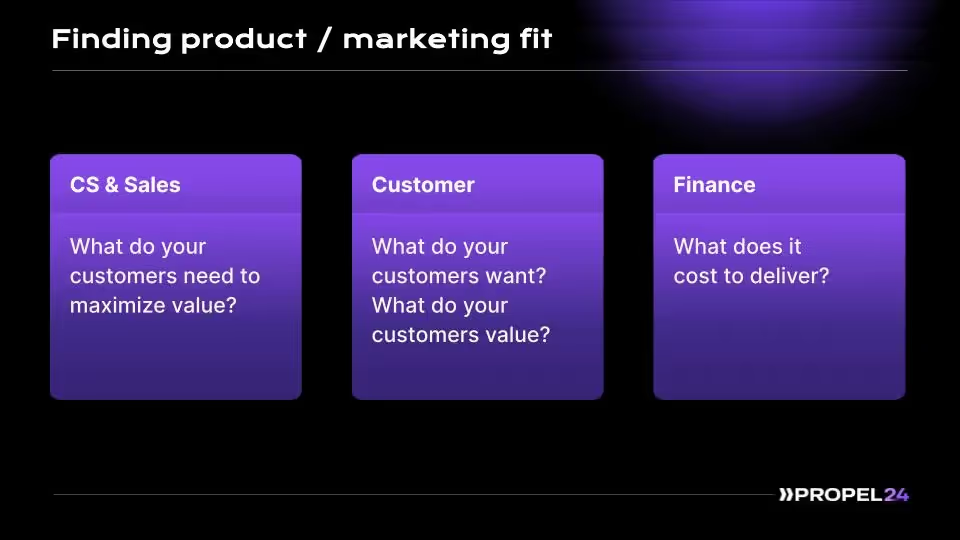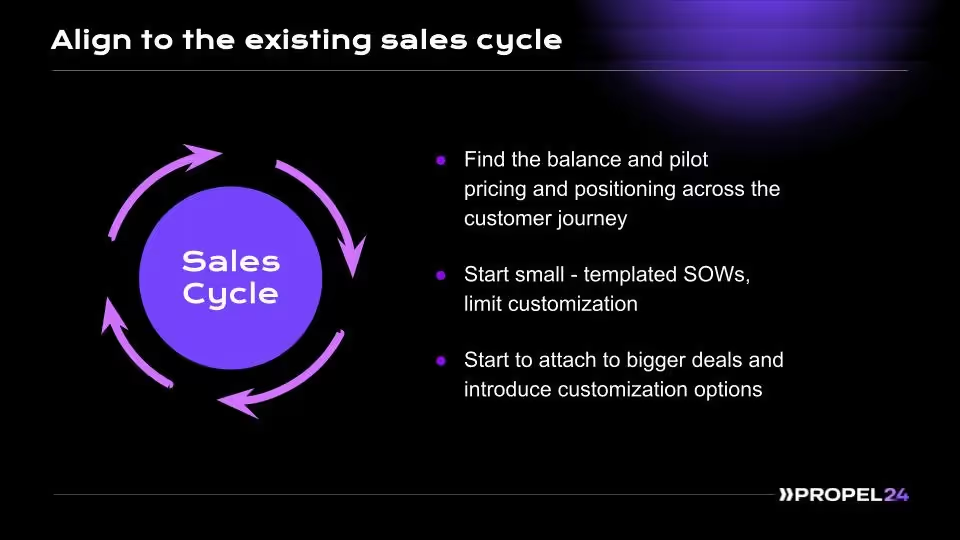The most effective service offerings are meticulously designed, consultative in approach, and, most importantly, aligned with long-term organizational objectives.
That's where seasoned experts like Dennis Mahoney come in.
Dennis draws from his extensive CS and PS leadership experience at companies like WalkMe, Mixpanel, and PwC Consulting to share ideas and insights on the development and sales of service products.
The Propel24 session focused on:
- The steps to finding product-market fit for service offerings
- 3 key relationships to nurture on this journey
- What it takes to build and grow a winning team
- Expanding and optimizing offerings, and more
3 key partners for finding product-market fit
As the first step in productizing services, you need to focus on understanding three key perspectives: directly from the customer, internally from customer success (CS) and professional services (PS) teams, and from the finance team.

1. Customer perspective
To understand customer needs, you need to focus on identifying:
- Customers' engagement preferences: Determine if customers want training, on-site visits, real-time customized training, or more flexibility in engaging with your team.
- Additional operational support: Assess whether customers can operate your product independently or need support such as staff augmentation or managed services.
- Value maximization: Identify what customers need to be successful and derive maximum value from your product.
2. Internal perspective from Customer Success and Professional Services
Collaborate with your Customer Success and Professional Services teams to understand:
- The team’s current needs: Evaluate where your CS and PS teams stand today and what resources or support they require to deliver services and support customers effectively.
- Customer trends and needs: Understand how customers move from initial adoption to becoming optimized and expanded users of your product.
- Recurring revenue drivers: Recognize what drives recurring revenue, whether it's seats/licenses, adoption models, or data usage. Gather insights on what customers need to optimize value and increase spend on your product.
3. Finance perspective
Establish a strong relationship with the CFO, to understand their goals and be able to speak to them in their language to make informed requests and investments. To build alignment with the finance team, you’ll need to focus on:
- Cost understanding: Analyze all the additional costs associated with delivering services and building your team
- Financial goals: Align with the financial objectives of your CEO, CFO, and board, such as driving revenue, recovering costs, or planning for future liquidity events
- Long-term planning: Develop a clear financial strategy that includes the P&L for professional services, ensuring alignment with the finance team
Developing a service offering
Based on conversations with customers, the customer service team, the sales team, and the finance team, you will have enough information to form a service offering. The key is to align this with the existing sales cycle.

Here are the best practices Dennis recommends for this phase of the journey:
- Develop a 4-slide elevator pitch: Start with a concise pitch outlining the value of your professional services. Create a basic four-slide presentation:
- Slide 1: Explain why customers need your services and the value they provide
- Slide 2: Detail the tangible outcomes or deliverables customers will receive (E.g. training, implementation, health assessments)
- Slide 3: Describe how you will deliver these services
- Slide 4: Introduce preliminary pricing based on delivery costs
- Standardize service offerings: Create a basic statement of work template and minimize customization. A "T-shirt sizing" approach can be helpful as you do this. For instance, your approach could include options like:
- Small: Limited scope
- Medium: Standard offering
- Large: Expanded scope with additional features
- Focus on new customers: Given that new customers are more receptive to paying for new offerings, it might make more sense to target new clients instead of existing ones for these services.
- Collaborate with the sales team: Work closely with the sales team in early-stage sales calls. Use your four-slide presentation to introduce your services and focus on listening to customer needs rather than discussing detailed pricing initially.
- Prioritize feedback over discounts: Avoid discounting early on. If necessary, offer free services in exchange for detailed feedback rather than marketing quotes or case studies. This feedback is crucial for refining your offerings in the early stages.
3 key internal relationships for designing service offerings
To build a successful professional services business, you must focus on three key partners: Sales operations, sales leadership, and CS/PS operations (PS/CS Ops). Each plays a critical role in the overall success.
1. Sales operations
The sales team is your most crucial ally in creating and selling service offerings. It's essential to dedicate time and effort to nurturing a solid partnership with them. Here's what Dennis recommends:
- Start by thoroughly understanding the sales team's compensation structure. Determine whether they receive one-time payments, non-quarterly bonuses, or Sales Performance Incentive Funds (SPIFs)
- Assess the current incentives and consider how you can integrate these into the launch of your professional service offerings, aligning them with the sales quotas and compensation plans
- Engage with sales teams regularly, seeking feedback and collaboration
- Use success stories to demonstrate the value of professional services, leveraging high-performing sales members as champions
2. Sales leadership
As you gain more experience, prioritize building strong relationships with your sales leaders. Here’s how to approach this:
- Build strong relationships with the sales leader: Attend their weekly team meetings and all-hands sessions to share updates on new service offerings and gather feedback.
- Acknowledge challenges: Understand the potential reservations and challenges of transitioning from free to paid services, especially in down-market scenarios.
- Be prepared to explain the value of charging for services like implementation, onboarding, and training.
- Put the spotlight on sales team members: Identify enthusiastic sales leaders and individual contributors who support the transition. Use their success stories during company-wide meetings, such as monthly all-hands or sales kickoffs. Have sales leaders and contributors share how professional services have delivered value and strengthened client relationships.
3. PS/CS Ops
PS/CS Ops ensures the smooth delivery and operational efficiency of services. To build an effective operational relationship:
- Track and manage the service pipeline and demand
- Ensure you have the capacity to deliver services and maintain high utilization rates
- Develop tools to monitor hours and time focused on customers
- Have contingency plans for subcontracting work if demand exceeds capacity, ensuring quality control
Building a winning team
On the operational side, it's essential to enable your business effectively to support the seamless delivery of services. This involves tracking pipeline activity, understanding demand trends, and ensuring that your team has the capacity to meet customer needs.
You also need to develop contingencies for overselling, and establishing partnerships with other organizations can help manage workload fluctuations and maintain service quality.
But just as important is investing in your team to help them succeed in this new way of business. successful service delivery relies on a balance of both sales and delivery capabilities, so it's essential to cultivate a team that excels in both areas.
Here’s what Dennis recommends:
- Improve commercial acumen across PS: Selling professional services requires understanding customer needs, positioning solutions, and pricing effectively. To support your team, you need to focus on development, recognition, and promotion.
- Sales acumen: Evaluate the commercial acumen of your team members. Identify team members who excel in these areas and those who need further development.
- Training and coaching: Provide targeted coaching and training to enhance your team's sales capabilities. This can include role-playing scenarios, sales strategy workshops, and shadowing successful sales calls.
- Skills matrix: Develop a global skills matrix to track and measure the competencies of your team members. This matrix should include technical skills, delivery capabilities, and sales acumen. Use this tool to guide promotions, recognition, and development plans.
- Ensure balanced workloads: Recognize and leverage the strengths of team members who excel in sales and customer interactions. Ensure a balanced workload for top performers, recognizing that they need to focus on both selling and delivering services. Avoid overloading them with sales responsibilities at the expense of delivery quality.
- Building a management bench: Identify potential leaders within your team who can take on managerial roles. Provide them with the necessary training and mentorship to develop their leadership skills. In addition, implement a succession planning strategy to ensure you have a pipeline of capable leaders who can step into key roles as the business grows.
Prioritizing continuous improvement
With the established service offering, the focus needs to shift to monitoring and measuring outcomes. It's no longer just about the time it takes to go live; it's about ensuring customers achieve adoption outcomes and derive value from what they're paying for.
Using metrics like Net Promoter Scores (NPS) and Customer Satisfaction (CSAT) surveys throughout projects to gauge satisfaction is key.
Another impactful metric to consider is referenceability. Referenceability measures whether customers are willing to serve as references for your organization. This serves as both a compensation metric for teams and a leading indicator of business success.
.avif)
Introducing recurring revenue
Transitioning from one-time implementation or training revenue to a recurring revenue model requires careful alignment with both sales and finance functions.
Attempting to bundle one-time services as recurring may not always be a good idea. Recurring revenue must be recurring in value.
You need to assess whether the offering truly lends itself to recurring outcomes, whether through ongoing support, maintenance, or other value-added activities.
Moreover, in recurring revenue models, keeping customers on board and encouraging them to renew and expand their subscriptions is key. One way to do this is to offer services like health checks, where you continually fine-tune how customers use your product. This not only keeps them engaged but also sets the stage for steady revenue streams.
Lastly, make sure everyone's on the same page about why transitioning to recurring revenue matters.
{{demo}}






















.webp)
